To prevent you wanting to use the rifle on your camera instead, you want to have, at least:
Also nice to have:
Initial Note: I consider a half-decent photograph of the inside of a rifle's barrel to show you ALL of the following:
This is a marginally-acceptable muzzle end bore photograph
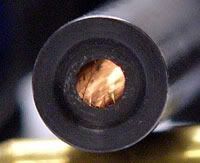
And here is a marginally-acceptable chamber-end bore photograph
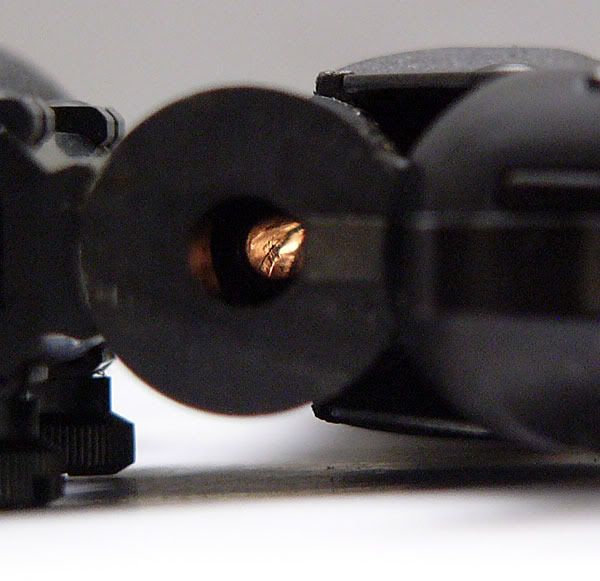
One thing you notice right away is that these bores are orange, and that is due to the orange bore light I was working with that day. A white bore light would be highly preferred to one that has ANY color. Note that an otherwise good photo to some extent mitigates the badness of having a severe color in the bore. Keep that in mind as you scroll down, taking note of the difference in those pictures taken with blue/violet lights. Photoshop can eliminate the color your light puts out, but if you don't know what you're doing, that can start to look inauthentic or "just wrong somehow" in a hurry.
First rule of bore photography: have decent lighting and that means a bore light.
No bore light: awfully hard to see what's going on in there!!
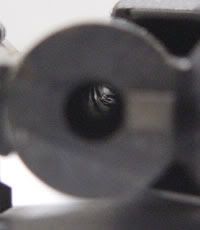
You don't have to use a purpose-made bore light. It can be pretty much any light source, as long as you can get enough light into the barrel. A purpose-made bore light however will have the advantage of not blinding you and your camera with extraneous light outside the barrel. Your bore light should be either adjustable or fairly bright. If it is adjustable, your job is that much easier: If it's too bright, just turn it down . When your light is not adjustable, you have to improvise. When it is too bright, you can either tilt the light source relative to the bore's axis:

OR separate the light from the bore by whatever distance is required

Okay, but why does the brightness have to be turned down? Don't you want bright lights?
Yes you do, and if your bore is badly rusted, pitted, or otherwise not mirror-bright, you will need as much light going in as you can muster, just to see it out the other end.
Why wouldn't you be able to see it? Aren't you looking right at the light? How could you not see it?
You don't want to look right at the light because you won't be able to tell what you're looking at in a photograph. Your eye can do all sorts of amazing things with its own lens, but a still photo does NOT convey the information you can see in a half-second with your unaided eye in person. This is what happens when you try to shoot a photo straight down the bore:
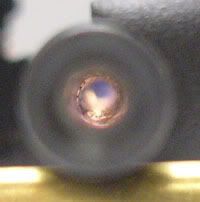
The blue is the measuring tape holding up the bore light (scroll up if you missed it). This is a view straight down the bore of our subject rifle, and out the other side. The brightness is useable, but unless your depth of focus is several INCHES, all you get is one spot of focus in several tens of inches of subject matter. Not very useful. If you did have a super-dee-uper lens, it's still not useful. All you would see is a bunch of spiraling lines really close together. Once again, not very useful.
But all you want to show is the muzzle end, you say? Okay, then suit yourself! Shoot straight down the bore axis and focus on the crown. How much better is this?
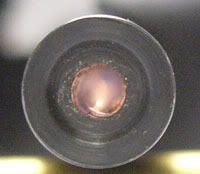
Hint: not very.
Angle the camera a little and you get this, which is MUCH better:

Okay, so we're at an angle. But don't you want a really bright light?
Unless you like wash-out, no, you don't. Unless you have a camera with full manual controls AND decent range of adjustment, you'll get this when your light is too bright:
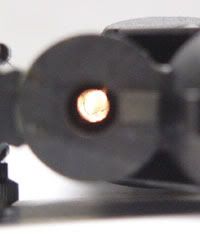
But all you want is to show the rifling! just speed up the shutter to cut down the glare right?
Tell me, is this
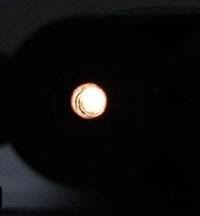
better than this?

No? Then back off or dim your light. Then you use your third hand to operate the camera. Or if you are a normal human with only 2 hands, try setting things up so you don't have to use both your hands on the setup. Leave the light where you don't have to hold it. Prop it on something or lay it so it works for your shot.
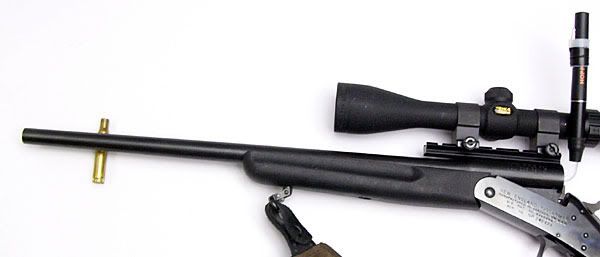

If your muzzle is not sitting high enough off the surface the gun rests on, you won't be able to look down its bore. No problem. do you have anything interesting-looking laying around you might use as a muzzle prop? I do:
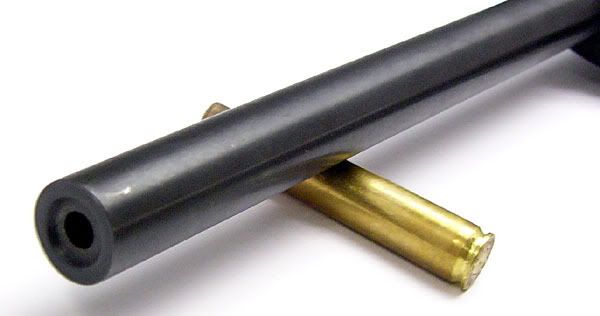
Now on to the camera. If you don't have manual controls for focus but your camera DOES have a half-click on the shutter button which allows you to focus before capturing the image, you can set something next to the subject at the proper focal depth, focus on that, move the camera to look at your subject, then shoot. Almost anything can be used for a focusing target, but if it stands up at a 90 degree angle relative to your subject (in this case vertical), is flat, and has high contrast, it will be easier to pull off the shot. If you don't have manual shutter speed control, setting up your lighting intensity and angle is CRITICAL to getting good exposure. If you don't have manual aperture control, you're stuck, but once again setup is KEY to a good shot. If you can adjust the aperture, crank it as small as it gets to try to get a little more depth of field in focus. For a point and shoot camera with NO controls, a good bet is to back off as far as you can (here's where the tripod comes in especially handy) and zoom in as much as possible, which tends to increase the depth of field at the expense of angle of view.
If your camera really stinks, lighting is that much more important, as you will have guessed by now. Ambient lighting that dims or brightens to suit your need can be a real help. This is something you will have to experiment with.
Sometimes you can't have it all in one photograph. Note in this series, how different lighting yields VASTLY different results. At first glance, this old Marlin looks worn, but okay. A rusty bore looks like nothing much from a shallow angle with a flash AND a bore light, or with just the (violet) bore light, but give it a steeper angle and only a flash, and the rust POPS out at you.
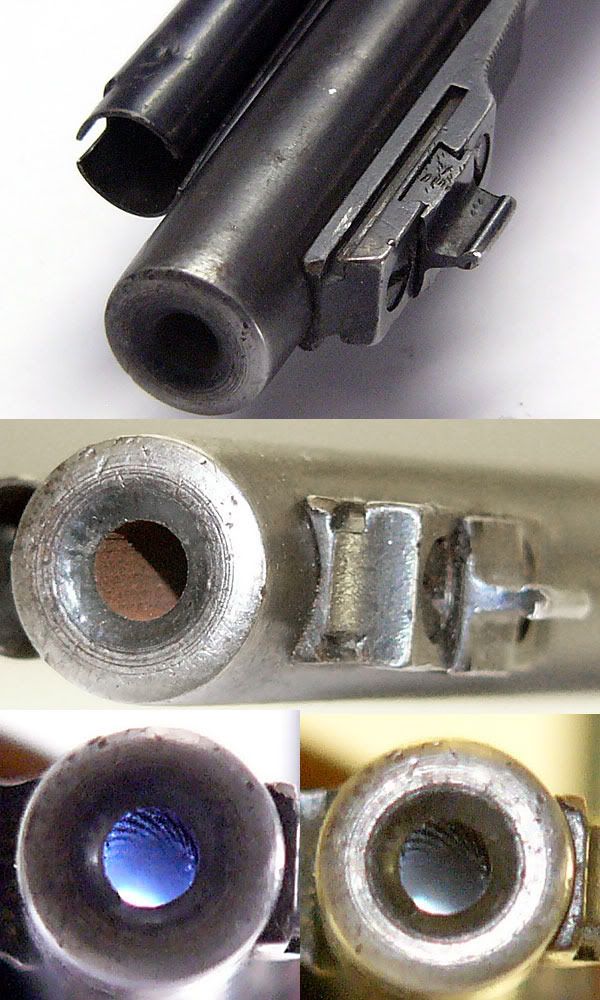
That's another thing: rust. If you are trying to play to a gun's strengths, dont use a flash if you can avoid it. A flash highlights rust and other surface flaws like a Hi-Liter. Don't conceal a gun's condition by light trickery if you (like me) are trying to sell it, because that's dirty pool. But don't break a sale by showing the gun in its worst possible light. Your goal for a photograph to help a sale should be an image that approximates what your buyer would see in person, with reasonable ambient and bore lights available. If there is noteworthy rust but your images don't show it, remember to make a note of rust in your description. Heavy rust is often a deal-killer. In most cases, I prefer to show heavy rust even if it takes a flash or some other trickery to do it. If you do end up with rust that looks worse in a picture than in person, I say you're justified in using Photoshop to reduce it.
It may be of some use to note that an adjustable-intensity flash may change color temperature as you turn it brighter or more dim. You will have to experiment with your equipment to find this out for yourself. If it turns yellow when you turn the flash down, that will bring the rust out even more. You might be able to adjust ambient lighting to mitigate this effect somewhat, but you may just have to back away, zoom in, and turn the flash back up. The other thing you can do to compensate for the colors imparted by a yellow flash, is speed and stop up the lens. F2.8/ and 1/60 second is a default flash-is-on setting on one of my cameras regardless of flash intensity. Stop that aperture to F8 and speed up to 1/125 second and the yellow magically disappears (along with some other, potentially interesting details in the image). If you are getting the idea that a lot of experimentation may be in order for you to find the right camera and lighting settings, you are right.
Note: sometimes zooming out gives a much more interesting photograph, as well as conveying more information about a gun's material condition. Consider how many words you can eliminate with this one shot:
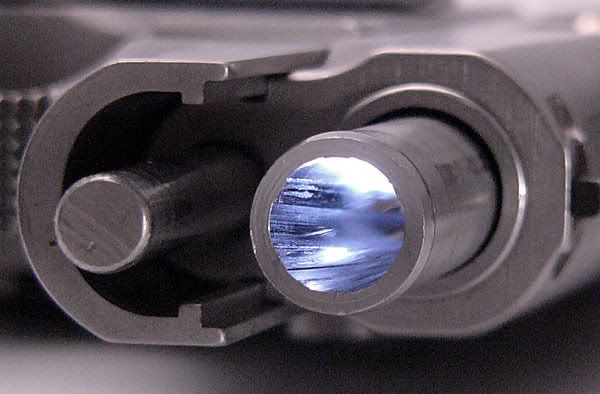
Sometimes you can't win for losing. Here's a micro-uzi with a frikken BEAUTIFUL bore. When you go look in this barrel with your eye, you will appreciate it in an instant. Shooting a photo of it was a bit confusing, until I realized that the lines coming out in the photos are actually reflections
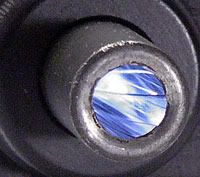
The Uzi's bore is so mirror-bright that it reflects itself back to itself repeatedly. This looks strange, so once again you will want to make a note of it in whatever text accompanies the photographs. Turning the light down reduces the reflections, but to eliminate them outright you need darkness, which is not helpful for taking photographs inside a hole.
Sometimes you will have some funky texture in the bore. I find that a different angle can be useful. You can't see very far down a narrow bore at a larger angle, but you can definitely show a prospective new owner just what he needs to know (in this case, pitted rifling):
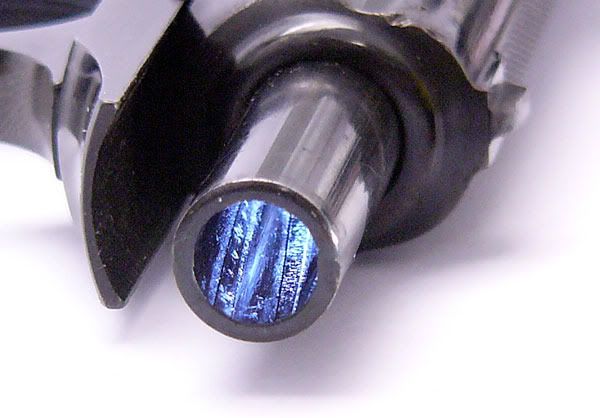
That goes for bad, as well as good:
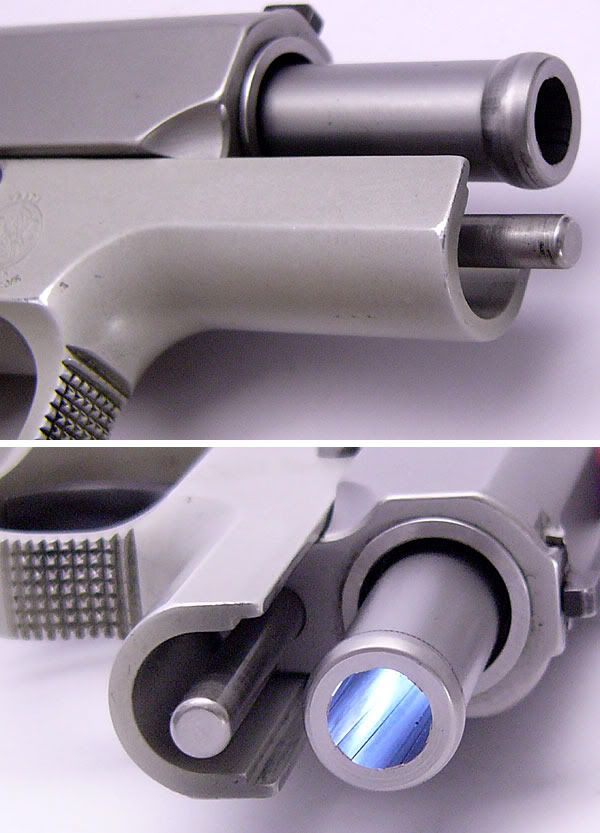
If you want to photograph a shotgun barrel, good luck. If it's mirror-bright, all you get is glare.
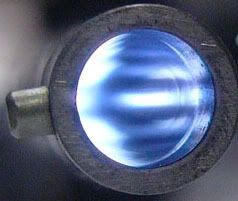
. . . and if it's not, it looks worse
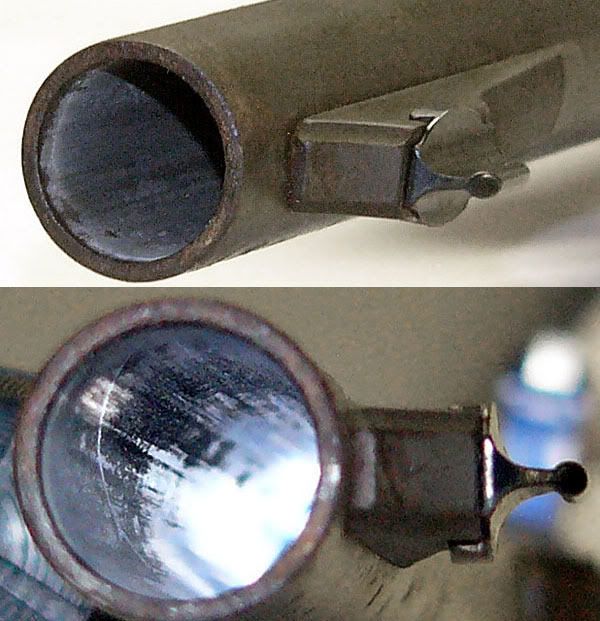
You have already seen some handgun barrels in the mix, but not any specific commentary about shooting photographs of a handgun's bore. The reason is that handguns present all the same challenges, but they are much easier to deal with than on a long gun.
In the list of nice things to have, I included an uncluttered background. This one is just a "nice to have" but think: do you really want a distracting floral print taking eyes off your new masterpiece?
A note on shooting the chamber, instead of the rifling: Good luck. Most of the tips I have given for rifling photos will not help much with chamber shots. You can't illuminate from the muzzle because there will usually be long shadows cast by the shoulder in the chamber. So it's bright direct lighting or none. You'll have to play with your flash a lot. If you had a ring flash around your lens it would help. If you have a separate light shining from close to stright-on, and shoot at a bit of an angle you might be able to pull it off. That's a deep hole to illuminate well. Unless you are a) far away and zooming in a lot or b) shooting straight-in (you wouldn't do that, would you?), any lighting not directly beside your lens is likely to wash out the breech face and not reach all the way to the end of a chamber, especially long chambers in higher-powered rifles. That said, unless you are concerned with showing damage, or showing off your madd photo skillz yo!, chamber shots may not be as important to a sale as rifling shots. Chamber problems may be fixable by a competent gunsmith; rifling problems, not so much.
The last tip I'll give you is to experiment as much as you can in the time you have available for photography. You will be surprised how much difference you can find in just a few degrees' difference in relative angles when you move your camera, lighting, or subject. Play with the manual controls on your camera. Adjust your lights. Try shooting freehand or on a tripod. If all else fails, take a break and come back. You may think of something while you are downing your triple mocha latte venti with a twist of pistachio (or whatever).
[Update 02/09/2011:]
This article was intended for beginners with low-end cameras, and a few more notes may be useful for a somewhat more-advanced photographer or one with better equipment. Here are a few notes from the same author/photographer, a couple of years farther down the road:
It turns out to be a big help to have a diffuse light source, go figure. I slapped a bit of scotch tape over the end of my little baby LED light. That turned it into a source of diffuse light, from the glare-O-matic it was before:

The resulting bore shots in a smooth shotgun bore (worst case) are somewhat less-bad than before. I have a feeling a 3/4" diameter translucent white ball on the end of the light would be as good as it gets for lighting a shotgun bore from the "other" end.
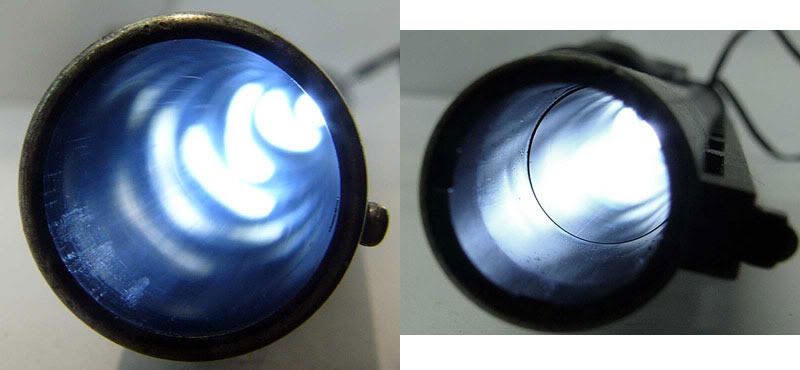
When using even an intensely-colored bore light, also using the flash and proper camera settings can yield good results. The colors surprisingly disappeared without having to do anything in Photoshop - the bore light in the following shots is the same violet light as before. This is what I got with a the aperture as small (F8) and the shutter as fast (1/2000sec) as possible. The camera was as close to the muzzle as the on-body flash would allow, which did fun things with the angle of the light from the flash, and was braced against the edge of the table. The background is moderately bright (around 500FC) near the muzzle, and it's by far the brightest shooting area in the house with hot spots around 1000FC. The background came out DARK, that's how much I used the camera's manual controls to crank down on the light input to the camera with these shots.
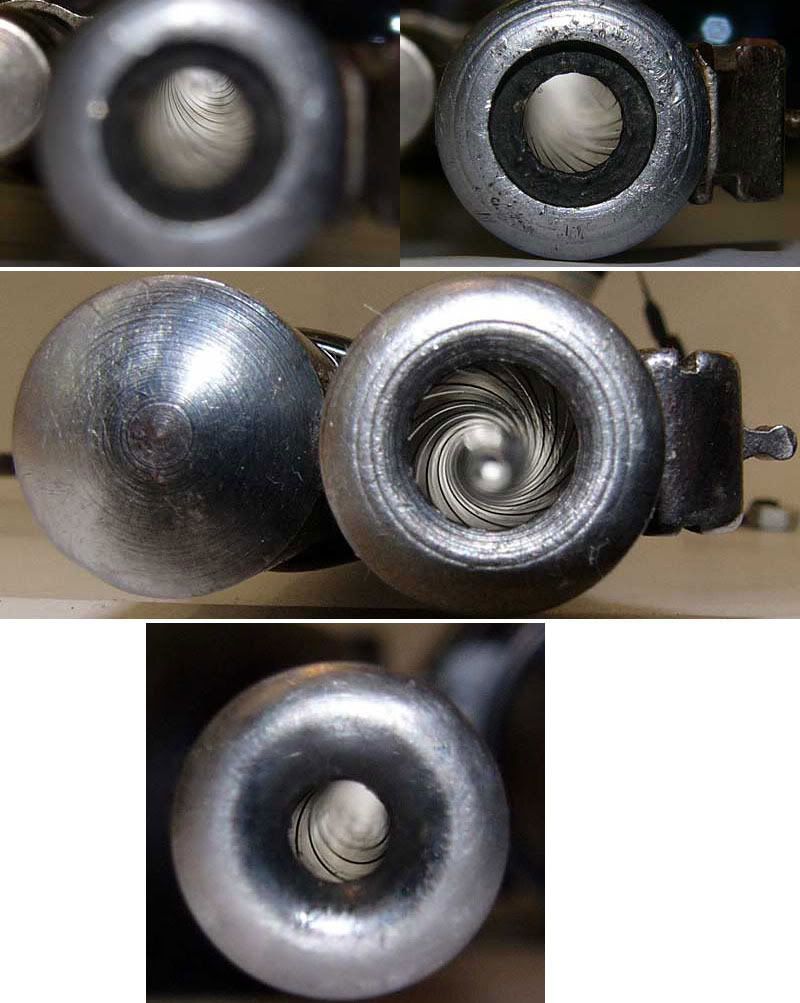
[/Update]
Moral of the story:
Shooting guns is fun, with bullets. Shooting guns with cameras can be frustrating. I don't claim to be the best photographer out there, and my equipment is a far cry from the best, but I hope this article is of some help to you.
Note for the safety commandos: it should be obvious from the fact that a light is shining through the barrel that the weapons in these images were unloaded when they were taken. Don't hassle me about Rule 1 and 2 violations thanks.
Originally posted 06/23/2009, updated 02/09/2011


No comments:
Post a Comment